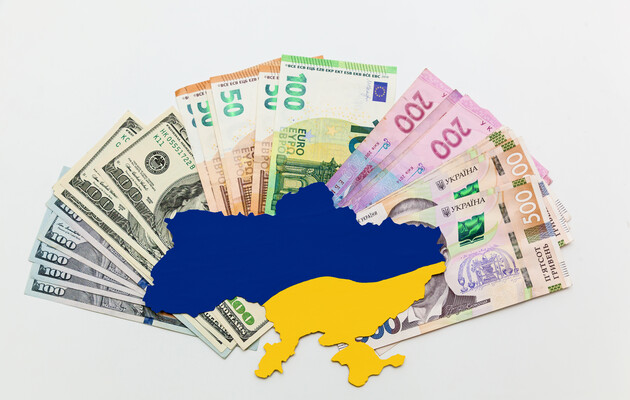Foreign Economic Performance and Risks of the Coming Year: Reading Our Balance of Payments
In 2023, the balance of payments was characterized by a number of significant features, namely growing financial support for Ukraine from Western allies and the expansion of the trade balance deficit. In 2024, the risks of instability associated with both current and financial operations of the balance of payments will continue to increase. In such a situation, maintaining the stability of foreign economic activity will require extraordinary efforts from the Ukrainian state and economic entities.
Despite a surplus in the amount of $8 billion in 2022, in 2023, the current account deficit of the balance of payments will amount approximately to $8.1 billion, or 4.6% of GDP. The positive balance of the financial account in 2023 may reach $19 billion, while in 2022 this balance was negative (see Table 1). The currency outflow from current transactions with an excess of its inflows from financial ones gives a positive overall balance, which in 2023 will be equal to about $12.6 billion.
In 2024–2025, the negative current account balance will, with a high probability, deepen, which is connected with the further increase of imports and the dwindling inflows of current transfers. Grant and humanitarian aid from abroad as a percentage of GDP is likely to experience a two-fold decrease compared to 2022–2023.
As a result, the current account deficit may reach 7.1% of GDP in 2024 and 9% of GDP in 2025. However, according to available forecasts, the overall balance of payments will remain weakly positive or zero as a result of vigorous credit support of the government of Ukraine by external donors.
In 2023, we will have a record deficit in the trade balance — approximately $39.5 billion, which is ten times greater than the deficit of 2021 and 1.5 times the deficit of 2022 (see Table 1). This is due to the fact that in the first year of hostilities, the export and import of goods and services decreased significantly, and in 2023, imports began to recover, while exports continued to decrease. In 2023, relative to 2021, the value of imports increased by 7.5%, and the volume of exports decreased by 37.4%.
The destruction of production facilities and infrastructure, the withdrawal of agricultural land from circulation and the reduction of the labor force due to hostilities undermine Ukraine's export capacity and deepen the gaps in the balance of payments. The same effect is caused by the blockage of transport routes for export by the aggressor and its henchmen in Poland, Slovakia and Hungary. At present, exports cover imports only 56.4%, while in 2021 this indicator was nearing 100%.
As part of commodity exports during the war, the supply of mineral products, ferrous and non-ferrous metals, products of chemical and related industries has decreased the most. In relation to imports, the highest growth rates were recorded in machinery, equipment, vehicles and appliances, as well as ferrous and non-ferrous metals and products thereof.
In addition to foreign trade operations, the outflow of foreign currency also occurs due to the acquisition of external financial assets by residents. The data in the picture indicate the main articles of inflow and outflow of foreign currency in Ukraine in 2023.
The growth of cash currency outside banks in 2023 will amount to about $11 billion. Based on the data on the international investment position of Ukraine from the National Bank of Ukraine (NBU), it can be predicted that at the end of the year foreign currency reserves in non-bank circulation will approach $120 billion, significantly exceeding the amount of hryvnia and foreign currency deposits in Ukrainian banks. Such are the consequences of chronically low confidence in the stability of the national currency and the results of the NBU's “attractiveness of hryvnia assets” policy. The capital outflow due to the increase in foreign exchange reserves narrows the financial potential of Ukraine in terms of supporting domestic investments and working capital of enterprises, whilst also increasing the instability of the balance of payments.
Gaps in Ukraine's balance of payments and budget deficit were largely covered by external official backing, whose volume in 2023 will amount to $41.2 billion. External financing of the government became the main component of Ukraine's gross international reserves, which at the beginning of December reached $38.8 billion.
Foreign aid has played a crucial role in supporting the military efforts of the Ukrainian state, maintaining macro-financial stability and ensuring the provision of public services (educational, medical, social) to the population during the war.
In terms of budgetary support, the largest donor to Ukraine in 2023 was the collective institutions of the EU, from which €16 billion of credit funds were received as of mid-December. The US allocated $10.9 billion in grant aid. Significant amounts of soft loans and guarantees came from the governments of Canada ($1.8 billion), Japan ($1.5 billion) and the UK ($1 billion).
As for the total financial, military and humanitarian aid to Ukraine since the beginning of the war, its volume reached €255 billion at the beginning of November (data from the Kiel Institute). The EU and its member states have documented €133.5 billion in aid to Ukraine, including €83.7 billion in financial aid and €41.4 billion in military aid (see Table 2). Currently, the EU accounts for 55% of the aid of Western democracies to Ukraine. At the same time, the United States pledged to provide Ukraine with three types of aid in the amount of €71.4 billion, including €42.9 billion in military aid.
In December 2023, during the review of the EFF program, the IMF increased the assessed Ukraine's external financing needs for the period until 2027 from $114 billion to $122 billion in connection with the growth of the planned budget deficit. According to the IMF, Ukraine has good prospects for receiving this financing, especially given the EU’s readiness to approve a €50 billion aid package for our country.
Unfortunately, however, the structure of international aid to Ukraine is dominated by loans: in 2023, their share will be 65%. This situation creates the danger of a debt crisis, since debt payments from the budgets of the following periods will increase rapidly. The IMF predicts that the size of state and state-guaranteed debt in 2025 will reach 98.5% of GDP under the base scenario and more than 130% of GDP under the downward scenario.
Table 3 shows the planned volumes of external financing of Ukraine for 2023 and 2024. Assistance from official bilateral donors will remain a major component of such funding. International partners and the IMF will allocate $37.3 billion to support next year's budget. This financing will be provided mostly on preferential terms. The estimated amount of net financing from the placement of domestic bonds will amount to only $3.8 billion.
The risks associated with obtaining external financing in 2024 are significant, and its rhythmic inflow is vital for maintaining economic stability. The solidarity of international partners with Ukraine and timely external financing in combination with the placement of bonds on the domestic market should lay a basis for the implementation of planned budget indicators, prevent government indebtedness and maintain socio-economic stability in the country.
In 2024, it is planned to carry out a so-called debt transaction – the restructuring of the sovereign debt to the owners of eurobonds with the write-off of some of its part. Debt relief would be an important step toward reducing the government's borrowing needs and equitably distributing the financing burden among different groups of creditors. In the Memorandum, the IMF emphasizes that the Ukrainian authorities must ensure savings via the debt operation in the amount of 1–1.7% of GDP per year in 2024–2027.
It is assumed that the debt operation will be consistent with the parameters of the IMF's debt sustainability analysis and will be premised on an equal treatment of different groups of creditors. It is expected that the process of restructuring the debt to the owners of eurobonds will start in January 2024 and will be completed by mid-year.
As was already mentioned, ensuring the solvency of the state and maintaining its macro-financial stability will require the restructuring of external debt to commercial and official bilateral creditors with the application of at least a 60% discount to the face value of debt obligations.
If a shock scenario takes place in 2024 — in the form of critical financing needs, a delay in external involvement, etc. — the government will be forced to resort to extraordinary measures. Among them there are the withdrawal of state deposits, reduction of budget expenditures, additional loans on the domestic government bonds market, obtaining monetary financing from the NBU.
Thus, the following will remain the key risk factors for the stability of Ukraine's balance of payments in the near future:
- a significant negative balance of trade in goods and services in the conditions of a continuing reduction in export revenues and sustained high import needs;
- the outflow of Ukrainian capital into cash currency and foreign securities in the presence of significant external financing needs;
- significant dependence on large-scale external financing, which is politically conditioned and potentially unstable.
In order to mitigate these risks, along with effective military defensive actions, it is extremely important to restore export capacities and unblock export routes, block the channels of withdrawal of national capital into foreign assets, strengthen the political coalition with Western allies and receive sufficient military and economic assistance from them.
Please select it with the mouse and press Ctrl+Enter or Submit a bug














.png)

 Login with Google
Login with Google